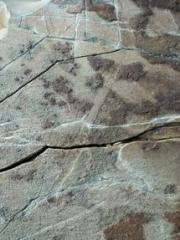Fossils show earliest animal trails

(PhysOrg.com) -- Trails found in rocks dating back 565 million years are thought to be the earliest evidence of animal locomotion ever found, Oxford University scientists report.
Trails found in rocks dating back 565 million years are thought to be the earliest evidence of animal locomotion ever found.
The newly-discovered fossils, from rocks in Newfoundland in Canada, were analysed by an international team led by Oxford University scientists. They identified over 70 fossilised trails indicating that some ancient creatures moved, in a similar way to modern sea anemones, across the seafloors of the Ediacaran Period.
The team publish a report of their research in the February edition of the journal Geology.
‘The markings we’ve found clearly indicate that these organisms could exert some sort of muscular control during locomotion,’ said Alex Liu of Oxford University’s Department of Earth Sciences, an author of the paper. ‘This is exciting because it is the first evidence that creatures from this early period of Earth’s history had muscles to allow them to move around - enabling them to hunt for food or escape adverse local conditions and, importantly, indicating that they were probably animals.’
Scientists compared the trails to those left by the modern sea anemone Urticina, and found many similarities suggesting that the animals that made them were anemone-like - perhaps using a muscular disc-shaped ‘foot’ to get around as anemones do today.
Evidence for animal movement from before the Cambrian Period (542-488 million years ago) is very rare, which has led many palaeontologists to suggest that earlier organisms were stationary and perhaps resembled modern fungi rather than animals.
Discovering evidence for animal movement in the Ediacaran Period (630-542 million years ago), nearly 30 million years before the Cambrian, is especially significant as it sheds light on the world before the so-called ‘Cambrian explosion’ in which a vast array of animal life rapidly appears in the fossil record - an event whose apparent suddenness greatly troubled Charles Darwin when he was gathering evidence for his theory of evolution.
‘As yet we aren’t able to say which Ediacaran organism created these trails, but this is evidence that these creatures had muscles as well as the stiff tissues, such as collagen, that gave their soft bodies some rigidity. It is also evidence that the ecology of this ancient marine environment was quite complex, perhaps approaching the complexity of later epochs,’ Alex Liu said.
‘Remarkably these newly-discovered fossils occur at a site called Mistaken Point which has been traversed by countless researchers over the years. It just goes to show that these old rocks still have many new things to tell us.’
More information: A report of the research, entitled ‘First evidence for locomotion in the Ediacara biota from the 565 Ma Mistaken Point Formation, Newfoundland’, is published in the February 2010 edition of the journal Geology.
Provided by Oxford University



















